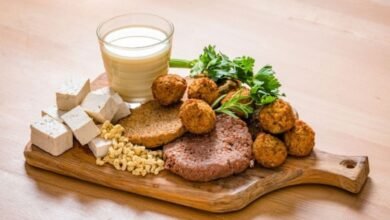How to Create Delicious Vegan and Vegetarian Dishes

The world of plant-based cuisine has never been more exciting. Whether you are a dedicated vegan, a vegetarian, or simply someone looking to add more plant-based meals into your diet, creating delicious vegan and vegetarian dishes can be a rewarding and satisfying experience. Not only do plant-based dishes cater to ethical and health-conscious consumers, but they also offer incredible flavor profiles, textures, and nutritional benefits. In this article, we will dive into the art of crafting mouthwatering vegan and vegetarian dishes that are both fulfilling and full of flavor. Whether you are a seasoned cook or a beginner, these tips and ideas will help you transform everyday ingredients into extraordinary meals.
Understanding the Differences Between Vegan and Vegetarian Dishes
Before diving into recipes and tips, it’s essential to understand the distinction between vegan and vegetarian diets, as it directly impacts the ingredients and preparation methods.
- Vegan Dishes: Vegan cuisine excludes all animal products, including meat, dairy, eggs, and even honey. The focus is on plant-based foods such as vegetables, fruits, legumes, nuts, seeds, grains, and plant-based alternatives for dairy and meat. The challenge with vegan dishes is ensuring they provide adequate nutrition, particularly protein, vitamin B12, and omega-3 fatty acids, which are typically found in animal-based foods.
- Vegetarian Dishes: While similar to vegan cuisine in that they do not include meat, vegetarian dishes often include dairy products (cheese, milk, yogurt) and eggs. This provides more flexibility in recipe creation and makes it easier to meet nutritional needs without relying on supplements or fortified foods.
Creating delicious meals for both vegan and vegetarian diets involves a blend of creativity, thoughtful ingredient choices, and culinary techniques. Now, let’s explore how to make these plant-based dishes vibrant, flavorful, and satisfying.
The Key to Flavorful Vegan and Vegetarian Dishes: Fresh Ingredients and Seasonings
One of the most important aspects of vegan and vegetarian cooking is using fresh, high-quality ingredients. With plant-based meals, the flavors often come from the natural profiles of fruits, vegetables, grains, and legumes. To elevate these ingredients, seasoning is crucial.
Embrace the Power of Herbs and Spices
Herbs and spices are what take vegan and vegetarian dishes to the next level. Instead of relying on meat for flavor, use fresh or dried herbs like basil, thyme, oregano, rosemary, and cilantro to enhance the flavors of your dishes. Spices such as cumin, turmeric, smoked paprika, cinnamon, and cardamom add warmth, depth, and complexity to plant-based dishes.
Experimenting with spice blends like garam masala, za’atar, or even homemade taco seasoning can instantly give your dishes an exotic flair. Don’t forget the basics—garlic, ginger, and onions form the base of many savory dishes and should be used generously.
Acid and Umami for Depth of Flavor
In vegan and vegetarian cooking, achieving a balanced flavor profile is crucial, and two components play a significant role in this: acid and umami. A touch of acidity—such as lemon juice, vinegar, or lime—can brighten up dishes and bring all the flavors together. Adding a splash of vinegar or a squeeze of fresh lemon juice to a hearty stew or grain-based salad can bring balance and complexity.
Umami, often described as the “fifth taste,” adds savory depth. Vegan ingredients like mushrooms (especially dried ones), miso paste, nutritional yeast, and tamari are packed with umami and can be used to mimic the savory notes typically found in animal-based dishes.
Building Blocks for Vegan and Vegetarian Dishes
Whether you’re cooking a simple weekday meal or planning a dinner party, knowing the building blocks of plant-based cuisine will make the cooking process smoother. These essential ingredients form the backbone of most vegan and vegetarian recipes.
Grains and Legumes
Grains such as quinoa, rice, barley, and farro are perfect for creating hearty bases in vegan and vegetarian dishes. They not only provide texture and bulk but also offer fiber, protein, and important vitamins and minerals.
Legumes like lentils, chickpeas, beans, and peas are excellent sources of plant-based protein and fiber. These are often used in vegan stews, curries, salads, and dips like hummus. Lentils, in particular, are quick to cook and versatile, making them a staple in any plant-based kitchen.
Vegetables as the Star of the Dish
Vegetables should be the star of most vegan and vegetarian dishes. Root vegetables such as carrots, sweet potatoes, and parsnips provide natural sweetness and earthiness, while leafy greens like kale, spinach, and chard are packed with nutrients and add color and freshness to meals. Cruciferous vegetables like broccoli, cauliflower, and Brussels sprouts offer a slight bitterness and are great for roasting, sautéing, or even incorporating into soups.
Don’t forget about the wonders of squashes, tomatoes, and peppers, which can be roasted, grilled, or blended into sauces. The beauty of vegetables is that they are incredibly versatile and can take on any flavor profile, from Mediterranean to Asian to Latin American.
Plant-Based Proteins
Since vegan and vegetarian diets often rely on plant-based proteins, it’s important to include high-protein foods in your meals. Tofu and tempeh are two of the most popular choices. Tofu is a soy-based product that can be marinated, grilled, sautéed, or crumbled into scrambles. Tempeh, which is fermented soybeans, has a nutty flavor and firmer texture, making it an ideal substitute for meat in stir-fries, sandwiches, and salads.
Seitan, or “wheat meat,” is another great option for vegans and vegetarians who miss the texture of meat. Made from gluten, it has a chewy texture and can be seasoned and cooked in a variety of ways. Additionally, plant-based protein powders or meat alternatives like Beyond Meat or Impossible Foods can be used to add protein to meals without sacrificing taste or texture.
Nuts, Seeds, and Dairy Alternatives
Nuts and seeds, including almonds, cashews, chia seeds, hemp seeds, and pumpkin seeds, are excellent sources of protein, healthy fats, and minerals. Cashews, in particular, are often used to create creamy vegan sauces, dressings, and even desserts.
Dairy alternatives are a crucial component of vegan and vegetarian cooking. From almond milk and oat milk to coconut yogurt and plant-based cheeses, these products can be used in everything from baking to making creamy pasta sauces. Nutritional yeast is another pantry essential for vegans—it adds a cheesy, umami flavor and is commonly used in pasta, salads, and vegan cheese sauces.
Creative Vegan and Vegetarian Dish Ideas
Now that we’ve covered the basics, let’s explore some creative vegan and vegetarian dish ideas that will impress your taste buds and inspire your culinary journey.
1. Vegan Buddha Bowls
Buddha bowls are a fantastic way to combine a variety of textures and flavors in a single meal. They usually consist of grains (quinoa or rice), protein (tofu, tempeh, chickpeas), vegetables (roasted sweet potatoes, kale, avocado), and a flavorful sauce (tahini dressing or peanut sauce). These bowls are not only delicious but also highly customizable to suit your tastes and dietary preferences.
2. Vegetable Stir-Fry with Tofu
Stir-fries are quick, versatile, and bursting with flavor. A mix of colorful vegetables—such as bell peppers, snap peas, broccoli, and carrots—combined with crispy tofu and a savory sauce made from soy sauce, sesame oil, garlic, and ginger, can make for a satisfying meal. Serve this stir-fry with brown rice or noodles for a balanced meal.
3. Vegan Lentil Soup
Lentils are a staple in vegan cooking, and a hearty lentil soup is both nutritious and comforting. By combining lentils with carrots, celery, onions, tomatoes, and vegetable broth, you can create a filling, protein-packed soup. Add fresh herbs like thyme and rosemary for an aromatic touch, and finish with a squeeze of lemon juice to brighten the flavors.
4. Grilled Vegetable Skewers
Grilled vegetables such as zucchini, eggplant, mushrooms, and bell peppers are perfect for summer BBQs or weeknight dinners. Marinate the vegetables in olive oil, balsamic vinegar, garlic, and herbs, and then grill them on skewers. These skewers can be served with quinoa, couscous, or in a wrap with hummus and greens.
5. Vegan Tacos
Tacos are a fun and customizable meal. For a vegan version, use seasoned black beans, roasted sweet potatoes, or sautéed mushrooms as the filling. Top with avocado, salsa, cilantro, and a squeeze of lime juice. You can also experiment with cashew cream or vegan cheese to make these tacos extra indulgent.
Final Tips for Creating Delicious Vegan and Vegetarian Dishes
- Experiment with textures: Mixing different textures—creamy, crunchy, chewy, crispy—can make plant-based dishes more exciting.
- Meal prep for convenience: Pre-chop vegetables, cook grains in bulk, or batch-make sauces to save time during the week.
- Balance macronutrients: Make sure your dishes include a good mix of carbohydrates (grains, legumes), protein (tofu, tempeh, beans), and healthy fats (avocado, nuts, seeds).
- Use seasonality to your advantage: Try to incorporate seasonal fruits and vegetables into your meals. Not only will they taste better, but they are often more affordable.
Creating delicious vegan and vegetarian dishes is all about being creative with ingredients and flavors. With the right spices, textures, and seasonings, plant-based meals can be just as exciting, diverse, and satisfying as their meat-based counterparts. Whether you’re looking to make a simple weeknight dinner
or impress your guests with a gourmet plant-based feast, these tips and recipe ideas will help you craft meals that are as delicious as they are nutritious.



